Books. Horticultural Review (2). Continued
Description
This section is from "The Horticulturist, And Journal Of Rural Art And Rural Taste", by P. Barry, A. J. Downing, J. Jay Smith, Peter B. Mead, F. W. Woodward, Henry T. Williams. Also available from Amazon: Horticulturist and Journal of Rural Art and Rural Taste.
Books. Horticultural Review (2). Continued
Under the head of "Belts of Plantation," our author says:
"Narrow strips or lines of plantation are among the most tasteless forms which belts can assume, and are equally mean and undignified wherever else they may occur, they can so readily be seen through, and will frequently present, at the lower parts, a mere assemblage of bare stems. Their effect is most meagre. They want breadth and massiveness. Hence, when plantations are necessarily so straightened, they should be composed mainly of such low-growing shrubs and dwarf-trees, especially evergreens, as will, by being planted tolerably close, and furnished down to the ground, produce a thicket-like character, that shall conceal or disguise their actual dimensions.
"In the subjoined sketches, Fig. 1 shows a narrow belt of trees, similar in size and character, such as is frequently seen around the margins of small parks, where, if undergrowth of any kind has ever been planted, it has become killed by the density and shade of larger trees. Fig. 2 will serve as a hint of the way in which such a belt may be broken up, and its form still more diversified by the use of a few intermediate bushes, such as Thorns and Hollies.

Fig. 1.

Fig. 2.
"The same defect, rendered, probably, a little more manifest from the superior beauty and variety of the ground line, will be apparent in Fig. 3, which exhibits a belt traversing an undulating surface. And the mode of remedying the evil is partially indicated in Fig. 4, where the trees are thrown into masses on the slopes and summits of the swells in the ground; the hollow being left unclothed for the purpose of marking the full extent of its depression".

Fig. a.
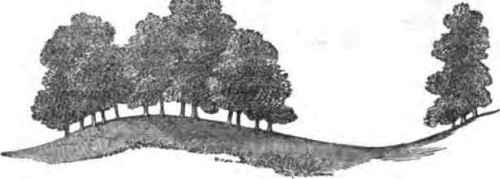
Fig. 4.
The observations on these topics are judicious throughout. Under the head of "Appearance of Extent," a subject as yet but little studied among us, by which a small space is enlarged in appearance, we copy the following: -
"Breadth of lawn must be fully attained before any notion of extent can be conveyed. A garden will always look meagre without a good open lawn. * * To make an open glade of lawn appear still larger than it is, the expedient of turfing closely around the plants and masses along its margin may be had recourse to. An object of one color, and that a green one, acquires a striking apparent augmentation of size. And if the plants that flank an open lawn are principally evergreens, and their branches sweep the grass, without any soil being visible, the space is thereby very much expanded in appearance. All walks should, as far as is practicable, be concealed from the house. * *
"There are certain features to be met with in some landscapes, which, though not in themselves inelegant, or deficient in beauty or interest, may have their character and effect very much improved by the way in which they are made visible from a place. Such are church towers and spires, (Fig. 5), pillars and obelisks, distant and pretty cottages, prospect and flag towers, ruins, lighthouses, windmills, and many other common-place erections, which may yet, from their position, their outline, or their historical or local associations, be worth directing attention to particularly. The most characteristic and effective plan of introducing such to view, is by-small openings in the interior or boundary plantations, which shall create a kind of vista, at the end of which the object intended to be seen occurs. If the sides of such vistas are tastefully and naturally finished off, without any appearance of formality or indication of art, and the trees in the outer landscape at all favor the design, very beautiful effects may be produced in this manner, out of the most ordinary materials. Or the framework of such openings may have a more artificial character (Fig. 6), the branches of trees or light wooden fences being made into a Roman or Gothic arch.
Or the same may be formed out of old stems of trees or wire trellises, clothed with climbers. Rude or more polished arches might also be' made of stone or plastered brick, or any similar substance. Either of these might form an artistic framework to a small scene, of which one object is the principal feature".
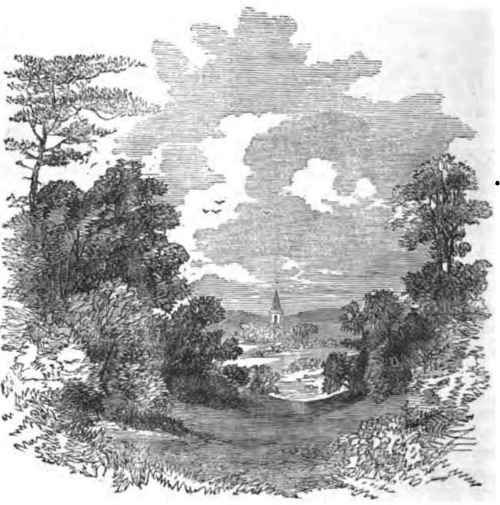
Fig. 5.
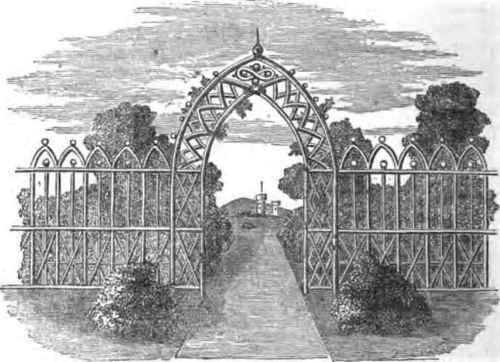
Fig. 6.
Space failing us in our cramped domain, we must defer some further extracts and illustrations for another number.
The retarding of bush fruit is a point too little noticed or attended to, and this chiefly through the pressure of other matters at the period proper to attend to them. Gooseberries, Bed and White Currants, Raspberries, etc., look exceedingly ornamental when trained on trellises, providing they can at all times be kept in trim. If, however, they cannot be properly attended to, such had better bo omitted. On perpendicular rails, too, they are very easily protected, or shaded, when requisite; and this is a consideration as to both earliness and lateness, as well as to birds. Trellises of strained wire are cheaply knocked up, and may be admirably adapted to their habits. Further, with regard to pruning in the reat-season, a too sparing hand is the common fault. Gooseberries, especially, require more thinning than is commonly awarded them. The interior shoots of the bush, in healthy trees, should be almost entirely pruned away, and the bearing confined chiefly to the extreme points. They are thus gathered with more ease: indeed, the bushes may be stripped in half the time of those choked up in the interior. The fruit, also, is much finer, and the crop will be found to tell amazingly in bulk.
As for the Red and White Currants, their side spray - if other points of management be right - may be all pruned close to within half an inch of the main stem. There is, thus, less summer spray to prune back, and the fruit is, in consequence, much larger. Those who grow for exhibition purposes may use liquid manure occasionally, during the swelling process, as also just before the fruit begins to color. This will much increase the size and general appearance.
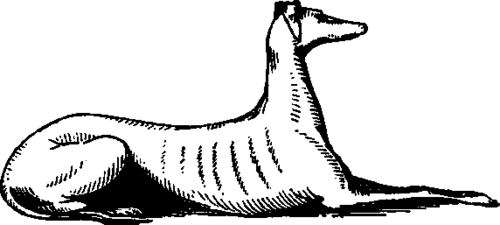
New Books. Horticultural Review #1

American Weeds and Useful Plants; being a second and illustrated edition of Agricultural Botany. By William Darlington, M. D. Revised, with additions by George THURNER, Professor of Materia Mediea and Botany, etc, in the New York College of Pharmacy. New York: A. 0. Moore & Co. 1859. This excellent reprint of a valuable book has laid too long on our table without notice; but other topics have been absorbing, and we now turn to it with the desire of impressing its importanceu pon our readers especially. Weeds require attention as much almost as our valuable crops, and it is something to know what they are and how to get rid of them. Some of our best plants may be weeds where they grow naturally, but we call all by the name which interfere with wholesome cultivation. In that thoughtful book entitled "Companions of My Solitude," by the author of "Friends in Council," the writer gives a picture of a puzzled little girl, who came running to his knees and held up a straggling and pretty weed. Then with great earnestness, and as if fresh from some controversy on the subject, she exclaimed, "Is this a weed, Papa? is this a weed?" "Yes, a weed!" he replied.
With a look of disappointment she moved to the one she loved best, and asking the same question, received the same answer. "But it has flowers," the child replied.
"That does not signify; it is a weed," was the inexorable answer; but, notwithstanding, the little girl asks Nicholas, the gardener, to plant it in her plot, which children walk about upon a good deal, and put branches of trees in, and grown-up flowers, and then examine the roots, (a system as encouraging as other systems of education that could be named), and which they call their gardens I" Dr. Darlington, long since, was anxious to call the attention of farmers and gardeners to the subject of weeds, about which so much neglect is too often apparent, and on his excellent frame-work Professor Thurber has erected a complete superstructure. This is a great advance on the original work because it is greatly enlarged, and it is capitally illustrated, an advantage which Mr. Moore, the publisher, is well qualified to direct, and if necessary, himself to perform, as well as to know when the performance is properly done.
To use no more words, however, on the subject, beyond an entire commendation of both matter and manner, we proceed to copy a few of the illustrations, in the belief that in doing so, we recommend the book to every cultivator. Our first picture will be the common Wild Grape, which if not a weed, is at least a cumberer of the ground, now that we have so many fine native varieties.
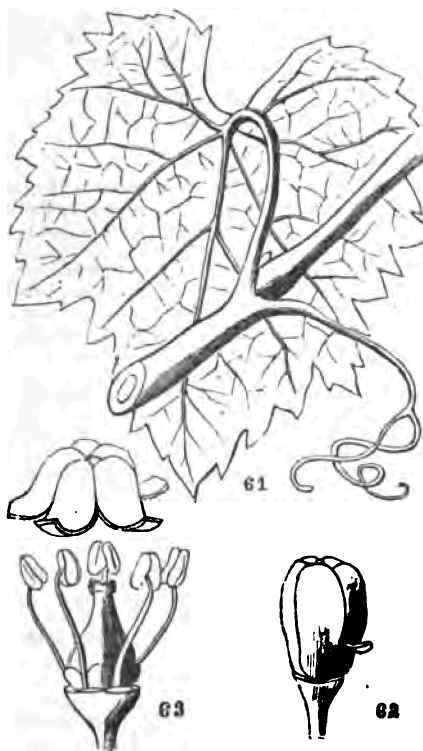
Common Fox Grape (Vitis Labrutca).
Continue to:


